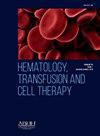阿塞拜疆CML患者对伊马替尼一线治疗的反应分析
IF 1.6
Q3 HEMATOLOGY
引用次数: 0
摘要
目的甲磺酸伊马替尼是一种选择性酪氨酸激酶抑制剂,已成为血液系统恶性肿瘤靶向治疗的原型。引入伊马替尼(IM)治疗慢性髓系白血病(CML)已显著改变疾病的自然进程。该药物专门用于抑制表达BCR/ABL1融合基因和干细胞因子、c-kit酪氨酸激酶和血小板源性生长因子受体的细胞增殖。通过实时定量聚合酶链式反应(RT-qPCR)监测阿塞拜疆慢性髓系白血病(CML)慢慢性期患者对甲磺酸伊马替尼(400mg /天)治疗的反应。本研究时间为2015年1月至2019年12月,纳入242例慢性粒细胞白血病(CML)慢性期患者。在开始IM治疗后3-5个月、6-11个月、12-17个月、18-23个月和≥24个月的特定时间间隔,从这些患者中共收集了1187份样本。其中69例患者在所有时间点进行了样本分析。以ABL1为对照基因,采用RT-qPCR定量BCR/ABL1。BCR/ABL1比率结果根据国际标准(IS)以百分数表示。结果所有时间间隔(n = 69)患者样本的分子反应谱显示,在第一个时间间隔(3-5个月),73.9%(51/69)患者的BCR-ABL1IS转录物水平降低了1个对数。在12-17个月时,监测显示92.7%(64/69)的患者至少减少了1个对数,而72.4%(50/69)的患者至少减少了2个对数。这一观察结果并不适用于第二组,因为一些患者的初始分子检测仅在开始IM治疗后12-18个月或更晚进行。结论不良反应与用药不当、不坚持治疗、监测延迟或继发耐药有关。正确坚持治疗和持续监测在治疗结果中起着至关重要的作用。这些发现重申了每三到六个月定期监测的必要性。这项研究表明,阿塞拜疆慢性粒细胞白血病患者在慢性期对IM的反应与国际随机研究报告的反应一致。本文章由计算机程序翻译,如有差异,请以英文原文为准。
ANALYSIS OF RESPONSE TO FIRST-LINE THERAPY WITH IMATINIB IN AZERBAIJANI CML PATIENTS
Objective
Imatinib mesylate is a selective tyrosine kinase inhibitor that has become the prototype for targeted therapy in hematologic malignancies. The introduction of Imatinib (IM) for the treatment of Chronic Myeloid Leukemia (CML) has significantly altered the natural course of the disease. The drug is specifically designed to inhibit the expansion of cells expressing the BCR/ABL1 fusion gene and receptors for stem cell factor, c-kit tyrosine kinases, and platelet-derived growth factors. To evaluate the response of Azerbaijani patients in the chronic phase of Chronic Myeloid Leukemia (CML) to treatment with imatinib mesylate (400 mg/day), monitored via Real-Time Quantitative Polymerase Chain Reaction (RT-qPCR).
Methodology
This study spans from January 2015 to December 2019 and includes 242 patients in the chronic phase of CML. A total of 1,187 samples were collected from these patients at specific intervals: 3–5 months, 6–11 months, 12–17 months, 18–23 months, and ≥24-months after the initiation of IM therapy. Among them, 69 patients had samples analyzed at all time points. The quantification of BCR/ABL1 was performed using RT-qPCR, with ABL1 serving as the control gene. The BCR/ABL1 ratio results were expressed as a percentage according to the International Scale (IS).
Results
The molecular response profile of patients with samples from all time intervals (n = 69) showed that during the first interval (3–5 months), 73.9% (51/69) of patients exhibited a 1-log reduction in BCR-ABL1IS transcript levels. At 12–17 months, monitoring indicated that 92.7% (64/69) of patients achieved at least a 1-log reduction, while 72.4% (50/69) attained at least a 2-log reduction. This observation did not apply to the second group, as initial molecular testing for some patients was only performed at 12–18 months or later after starting IM therapy.
Conclusion
Unsatisfactory responses can be attributed to improper drug use due to side effects, non-adherence to therapy, delayed monitoring, or secondary resistance to the drug. Proper adherence to treatment and consistent monitoring play crucial roles in therapeutic outcomes. These findings reaffirm the necessity of regular monitoring every three or six months. This study demonstrates that the response to IM in Azerbaijani CML patients in the chronic phase aligns with the responses reported in randomized international studies.
求助全文
通过发布文献求助,成功后即可免费获取论文全文。
去求助
来源期刊

Hematology, Transfusion and Cell Therapy
Multiple-
CiteScore
2.40
自引率
4.80%
发文量
1419
审稿时长
30 weeks
 求助内容:
求助内容: 应助结果提醒方式:
应助结果提醒方式:


